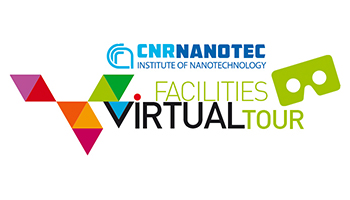Main Focus Areas

The research activities of the CNR Nanotec Institute are focused on the following main focus areas:
- Advanced Devices
- Materials Science
- Computational Physics and Biology
- Nano-Biotechnology
- Photonics & Optoelectronics
- PlasmaCheM
Keywords: Perovskite Solar Cell (PSC), Solid State Electrochromic (EC) Devices, Quantum dot Solar Cell (QDSC), Smart Windows, GaN Technology, Spintronic Devices, Nano-electronics, High Quality Microcavities, Wearable Printed Electronics, Charge Transport,Time of Flight (TOF), Charge Extraction by Linearly Increasing Voltage (CELIV), Thermally Stimulated Current (TSC)

The Advanced Devices area focuses on the implementation of multifunctional structures, new generation micro / nanostructured devices with application in the fields of energy production, energy saving, miniaturized electronics, photonics, diagnostics and precision medicine.
Specifically, the use of advanced bottom-up and top-down approaches allows to design and manufacture devices based on organic, inorganic and hybrid materials, on rigid and flexible substrates with innovative features compared to the state of art at high Technology Readiness Level (TRL).
Keywords:

Our research is dedicated to the development of advanced organic materials based on conjugated functional systems. We design and synthesize new molecular building blocks and explore their opto-electronic properties in solution and in the solid state in order to obtain new materials which can be employed as active elements in optoelectronic devices. Moreover, photochemical and photophysical characterization of optically active materials in the UV-VIS-NIR spectral windows at liquid and solid phases are performed. In particular, photoinduced energy and electron-transfer processes in organic and inorganic dyes.
Keywords:

At NANOTEC, experimental research in condensed matter, material science, advanced photonics, and
nano-biotechnology is supported by a well-established theoretical and numerical research
activity.
This focuses on:
- the theoretical and computational study of systems with many interacting constituents, from glasses and spin glasses to soft and biological matter; and the physics of random lasing materials;
- turbulent and complex flows;
- the quantitative and computational analysis of biological systems, from single-molecules to biological networks and system-level properties.
Keywords: Artificial Bioconstructs, High-resolution Imaging, Molecular Genetics, Nanodiagnostics, Nanostructured Surfaces, Organ-on-chip Technologies, Smart Biomaterials, Stimuli-responsive Carriers, Precision Medicine

Nano-Biotechnology focuses on the development of advanced tools and hybrid materials for biomedical science and translational medicine. We apply multi-disciplinary approaches to realize novel nanomaterials and nanostructures suitable in several fields of nanomedicine, including drug and gene delivery, biosensing, lab on chips & organ on chips. In particular, we are interested in studying the self-assembly of biomolecules at interfaces, the (bio)chemical/physical properties of naturally active or engineered (e.g., self-propelling, light-responsive, pH-responsive) nanoparticles, as well as the fundamental processes and functions in cellular and molecular biology. Other fields of interests are “point-of-care” diagnostic tools, 3D biomaterials engineering, plasma modified materials and liquids for precision and personalized medicine. Studies carried out in this research area generally integrated with Computational Biology and Plasma Medicine approaches.
Keywords: Condensates, Polaritons, Non-Linear Optics

One of the main areas of investigation on the frontiers of physics is the interaction and coupling of light and matter, both from a macroscopic point of view, and on the single particle level. Coherent and collective phenomena such as Bose-Einstein condensation are studied in semiconductor materials and devices, exploiting polaritons: quasi-particles generated by the strong coupling between photons and excited states of matter. Polaritons exhibit very strong nonlinearities, allowing the observation of superfluid dynamics, among the most striking manifestations of macroscopic quantum physics. In particular, we are interested in the dynamics of quantized vortices, optically guided non-equilibrium condensates and the expansion or entrapment of quantum gases. Other fields of interest are the correlation of quantum states and the development of polariton systems based on new materials. In general, inorganic semiconductors and organic or hybrid materials are studied from a fundamental point of view as well as for new application concepts, such as optical transistors, photonic logic gates, machine learning and reservoir computing, up to the most futuristic lines of quantum information processing.
Keywords: Plasma Deposition, Plasma Processing, Surface Functionalization, Processes Development, Materials Growth, Nanostructures, Biomaterials, Coatings

Plasmas are used to deposit or remove/etch materials and nanostructures in a controlled way making possible intricate patterns on a large variety of substrates, including wafers of silicon for microelectronic, glass, ceramics and plastics. Plasma-aided fabrication is an integral part of electronics and semiconductor manufacturing. It is used in the manufacturing of everyday devices such as computer processors, RAM, hard drives, monitors, television displays, and solar cells. Progress in plasma research has proved essential to the rapid miniaturization and increased performance of electronics.
Plasma-surface interaction processes are investigated predominantly in dedicated laboratory experiments and the understanding of these interactions is used to develop new technologies with far-reaching applications as well as to endow solid surfaces and materials with new functionalities. Plasma at room temperature and atmospheric pressure is used in biotechnology and medicine to sterilize surgical equipment, to disinfect clothing or surfaces and to modify cellular growth. Its antibacterial and antimicrobial properties also mean it can be used for wound care. Initial research into cold plasma applications has explored their uses in medicine, particularly for infection control and cancer therapy. Plasma research is also dedicated to the potential uses of the antimicrobial properties of cold plasma in agriculture and food for livestock healthcare and biosecurity, food hygiene and shelf-life extension. The plasma technology has the ability to reduce harmful chemicals and antibiotics in the food chain. Plasmas are also applied to environmental science and engineering, including contaminated soil and wastewater remediation, metal recovery from waste solutions, sterilization and air pollutant abatement.
We provide a balanced and comprehensive expertise in the core principles, novel plasma reactors and diagnostics, and state-of-the-art environmental applications of plasma.
